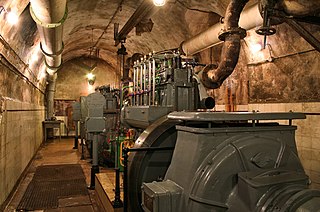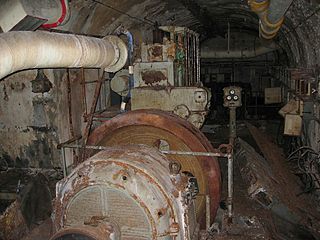
Ouvrage du Kobenbusch is a gros ouvrage of the Maginot Line, located in the Fortified Sector of Thionville in the Cattenom forest. It possesses seven combat blocks and two entrance blocks, one for ammunition and the other for men. It is located between petit ouvrage Bois-Karre and petit ouvrage Oberheid, and was named for the surrounding Kobenbusch forest.

Ouvrage Mont des Welches, a gros ouvrage of the Maginot Line fortifications, is part of the Fortified Sector of Boulay. It comprises two entrance blocks, one infantry block, one artillery block, one observation block and two combination blocks. It is located between petit ouvrage Coucou and gros ouvrage Michelsberg, facing Germany. Relatively small for a gros ouvrage, Mont des Welches saw a brief period of sharp action in June 1940, when German forces moving along the rear of the Maginot Line engaged the position without success. After modest renovations in the 1950s, Mont des Welches was abandoned in the 1970s.

Ouvrage Michelsberg, one of the Maginot Line fortifications, formed part of the Fortified Sector of Boulay as well as the fortified region of Metz. The ouvrage is located in Moselle (département) between the towns of Dalstein and d'Ebersviller, about 23 km from Thionville. It is located between gros ouvrage Mont des Welches and petit ouvrage Hobling, facing Germany. Michelsberg did not see significant action in the Battle of France until June 1940, when it was attacked from the rear by German forces that had bypassed the Maginot Line. It successfully resisted these attacks, but was compelled to surrender in accordance with the 25 June 1940 armistice. After the Second World War it was renovated as a Cold War fortification against a potential Soviet invasion, then abandoned. It is now operated as a museum, and may be visited.

Ouvrage Anzeling is a gros ouvrage of the Maginot Line, part of the Fortified Sector of Boulay. It is located between petit ouvrage Bousse and petit ouvrage Berenbach, facing Germany just to the east of Bockange. With one of the longest main galleries of any Maginot position, it consists of two entrance blocks, three infantry blocks and four artillery blocks. A second phase of construction was planned to add nine more combat blocks and an anti-tank ditch, but was never executed. Anzeling saw limited action in World War II, and was rehabilitated for use during the cold war. It was de-activated in the 1970s and sold for private use.

Ouvrage Coucou is a lesser work of the Maginot Line, located in the Fortified Sector of Boulay. The ouvrage consists of two infantry blocks, and is located between the gros ouvrages of Hackenberg and Mont des Welches, facing Germany, just north of Kemplich.

Ouvrage Bousse, also known as Ouvrage Bois de Bousse, is a lesser work of the Maginot Line in the Fortified Sector of Boulay. The ouvrage is located between petit ouvrage Hobling and gros ouvrage Anzeling, near Hestroff in the Bois du Bousse, facing Germany. A small position, it was manned primarily by reservists. It is noted for the events of 15 June 1940, when it received orders to prepare for an evacuation as German forces advanced along the Line in the Battle of France. As the garrison prepared to abandon the position, sabotaging equipment, they destroyed their telephone connection, leaving them unable to receive the order countermanding the evacuation. The garrison was captured three days after leaving Bousse. Bousse is now managed as a museum and is open to public visitation.

Ouvrage Berenbach, also known as Ouvrage Behrenbach, is a lesser work of the Maginot Line. Located in the Fortified Sector of Boulay, the ouvrage is located between gros ouvrage Anzeling and petit ouvrage Bovenberg, facing Germany. The ouvrage consists of two infantry blocks and one observation block. Uniquely, the blocks are not connected by subterranean galleries, as is the case in virtually all other Maginot fortifications.

Ouvrage Bovenberg is a lesser work of the Maginot Line. Located in the Fortified Sector of Boulay, the ouvrage is located between petits ouvrages Berenbach and Denting, facing Germany. It consists of two infantry blocks and two artillery blocks.

Ouvrage Denting is a lesser work of the Maginot Line. Part of the Fortified Sector of Boulay, the ouvrage consists of three infantry blocks, and is located between petits ouvrages Bovenberg and Village Coume, near the village of Denting in Moselle département, facing Germany. The position saw little action in World War II.

Ouvrage Village Coume is a lesser work of the Maginot Line. Located in the Fortified Sector of Boulay, the ouvrage consists of three infantry blocks, and is located between petits ouvrages Bovenberg and Coume Annexe Nord, facing Germany. The position saw little action in World War II. It was sold in the 1970s and stripped by salvagers.

Ouvrage Coume is a lesser work of the Maginot Line. Located in the Fortified Sector of Boulay, the ouvrage consists of two infantry blocks, and was located between petits ouvrages Coume Annexe Nord and Coume Annexe Sud, facing Germany.

Ouvrage Coume Annexe Sud is a lesser work of the Maginot Line. Located in the Fortified Sector of Boulay, the ouvrage consists of two infantry blocks, one artillery block and one observation block, and is located between petits ouvrages Coume and Mottemberg, facing Germany.

Ouvrage Mottenberg is a lesser work of the Maginot Line. Part of the Fortified Sector of Boulay, the ouvrage consists of one entrance block and two infantry blocks, and is located between petits ouvrages Coume Annexe Sud and Kerfent, facing Germany.

Ouvrage Métrich located in the village of Kœnigsmacker in Moselle, comprises part of the Elzange portion of the Fortified Sector of Thionville of the Maginot Line. A gros ouvrage, it is the third largest of the Line, after Hackenberg and Hochwald. It lies between petit ouvrage Sentzich and gros ouvrage Billig, facing Germany. Located to the east of the Moselle, it cooperated with Ouvrage Galgenberg to control the river valley.

Ouvrage Aumetz is a small work, or petit ouvrage of the Maginot Line. It is part of the Fortified Sector of the Crusnes and is located near the community of Aumetz in the Moselle département of France. The petit ouvrage flanked by the gros ouvrages Bréhain and Rochonvillers, all facing the France-Luxembourg border. Aumetz was initially planned as a gros ouvrage of six combat blocks, but only three infantry blocks were built. Aumetz saw limited action during the Battle of France. In the 1970s it was the first Maginot position to be offered for sale to the public.

Ouvrage Immerhof, also known as Ouvrage Ferme-Immerhof, is one of the largest petit ouvrages of the Maginot Line of northeast France. Located near the community of Hettange-Grande, it is 7 km north of Thionville between the gros ouvrages of Molvange and Soetrich, the closest ouvrage to the Luxembourg frontier. It was part of the Fortified Sector of Thionville, in the Fortified Region of Metz, the strongest portion of the Line. Apart from its function as a communication post between the neighbouring gros ouvrages, Immerhof also controlled the road and railway routes from Luxembourg, which pass in the immediate vicinity. In addition, Immerhof protected other Maginot works in the vicinity: the casemates of Kanfen, the infantry shelter of Stressling, the observation point and shelter of Hettange-Grande, and a number of nearby blockhouses constructed during the Phoney War.

Ouvrage Soetrich is a gros ouvrage of the Maginot Line in northeastern France. Soetrich is located between petits ouvrages Immerhof and Bois Karre, facing the France-Luxembourg border near the town of Hettange-Grande, part of the Fortified Sector of Thionville. Compared with other gros ouvrages, Soetrich is compact in arrangement, with the entries and underground ammunition magazines and barracks in close proximity to the combat blocks, accessed through underground galleries at an average depth of 30 metres (98 ft). Its primary purpose was to cover the main road to Luxembourg, just to the west. Along with its neighbors, Ouvrage Rochonvillers and Ouvrage Molvange, Soetrich was used during the Cold War as a secure command center for NATO forces.

Ouvrage Otterbiel forms part of the Maginot Line in the Fortified Sector of Rohrbach, Sub-sector of Bitche, and is located on the Camp de Bitche of the French Army. It is located between gros ouvrage Schiesseck and petit ouvrage Grand Hohekirkel. Part of the Fortified Sector of Rohrbach, the petit ouvrage comprises four combat blocks and an entry block. Due to budget restrictions, a planned flanking infantry block was never constructed. Otterbiel saw no significant action in the Battle of France, and limited action during the 1944/45 Lorraine Campaign. It was renovated for use during the Cold War. Otterbiel is used for ammunition storage by the French Army.

Ouvrage Schiesseck is a gros ouvrage of the Maginot Line, located near Bitche in the French département of Moselle. Schiesseck is adjoined by gros ouvrage Simserhof and petit ouvrage Otterbiel, all part of the Fortified Sector of Rohrbach, and faces the German frontier. Schiesseck saw comparatively little activity during the Battle of France, surrendering with other positions in its sector on 30 June 1940. During the Lorraine Campaign of 1944 Schiesseck was occupied by German forces and presented a point of resistance to American advances, requiring heavy bombardment and infantry assaults by engineer units to capture. The area was abandoned during the Battle of the Bulge, but was recaptured in March 1945. In the 1950s Schiesseck was repaired as part of a program to re-arm the Maginot Line against a potential advance by Warsaw Pact forces. It was abandoned in the early 1970s. Schiesseck is on military land and is not visitable by the public.

Ouvrage Grand-Hohékirkel is a petit ouvrage of the Maginot Line, located near Bitche in the French département of Moselle. Grand-Hohékirkel is adjoined by gros ouvrage Otterbiel to the west and petit ouvrage Lembach at some distance to the east, and faces the German frontier. It was part of the Fortified Sector of the Vosges.










